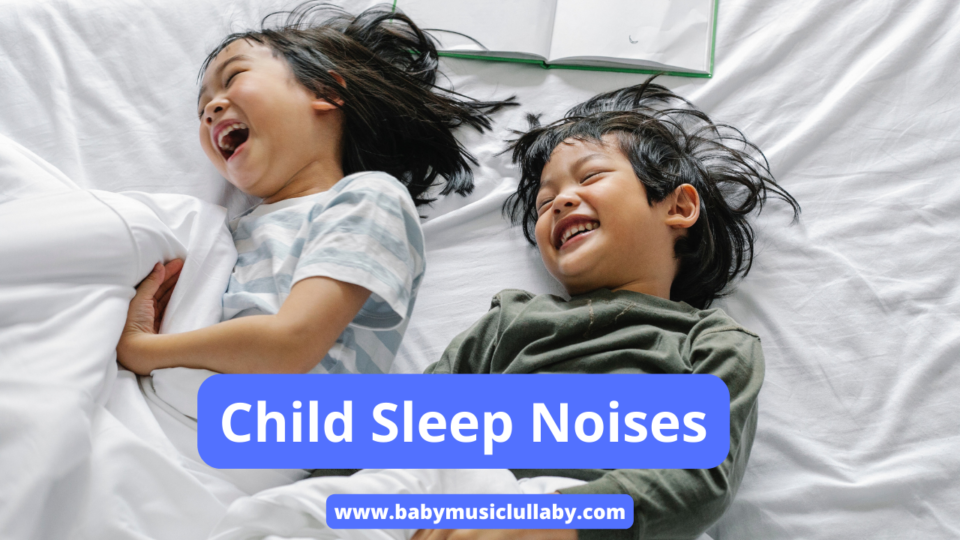Contents
Introduction
When it comes to your child’s sleep, it’s not uncommon to hear various noises during the night. Sleep noises can range from soft murmurs to loud snoring or even occasional sleep talking. Understanding the different types of sleep noises and their potential causes can help you ensure that your child is getting the restful sleep they need. In this article, we will explore common child sleep noises, their significance, and how to manage them effectively.
Understanding Child Sleep Noises
Children, like adults, go through various sleep stages during the night, including deep sleep, light sleep, and rapid eye movement (REM) sleep. These different sleep stages can influence the sounds your child makes while asleep. Sleep noises can be a result of their breathing patterns, muscle relaxation, or even dream activity. In most cases, these sleep noises are harmless and a normal part of the sleep process.
Common Sleep Noises and Their Causes
- Snoring: Snoring is a common sleep noise caused by the vibration of respiratory structures. It can occur when the airway becomes partially blocked during sleep. Snoring in children is often harmless but can sometimes indicate underlying issues such as enlarged tonsils or adenoids.
- Sleep Talking: Sleep talking, or somniloquy, is the act of speaking during sleep. It can range from mumbling to full sentences and is more common in children than adults. Sleep talking is generally harmless and tends to decrease as a child grows older.
- Teeth Grinding: Teeth grinding, or bruxism, is the involuntary clenching or grinding of teeth during sleep. It is relatively common in children and usually resolves on its own without causing any long-term damage to the teeth. Stress, anxiety, or misaligned teeth can contribute to teeth grinding.
- Restless Sleep Movements: Children may exhibit restless sleep movements, such as kicking, twitching, or tossing and turning. These movements are often a normal part of sleep and can occur during periods of dreaming or muscle relaxation.
When to Be Concerned About Sleep Noises
While most sleep noises are harmless, there are instances where they might indicate an underlying issue. If you notice any of the following, it’s advisable to consult a healthcare professional:
- Loud, persistent snoring accompanied by gasping or choking sounds.
- Pauses in breathing during sleep.
- Excessive daytime sleepiness or difficulty staying awake during the day.
- Severe teeth grinding that causes jaw pain or tooth damage.
- Sleep disturbances that significantly impact your child’s quality of life.
Tips for Managing Sleep Noises
- Create a Relaxing Sleep Environment: Ensure that your child’s sleep environment is calm, comfortable, and conducive to sleep. A dark, quiet room with a consistent temperature can help promote better sleep.
- Address Underlying Issues: If you suspect that sleep noises are caused by an underlying issue, such as enlarged tonsils or misaligned teeth, consult a healthcare professional for further evaluation and appropriate treatment options.
- Establish a Bedtime Routine: A consistent bedtime routine can signal to your child’s body that it’s time to sleep. Include calming activities such as reading a book or listening to soothing music to help them unwind before bed.
- Encourage Healthy Sleep Habits: Promote good sleep hygiene by establishing regular sleep and wake times, limiting screen time before bed, and ensuring your child gets enough physical activity during the day.
- Practice Relaxation Techniques: Teach your child relaxation techniques, such as deep breathing or visualization exercises, to help them relax before sleep and potentially reduce sleep noises.
Frequently Asked Questions About Child Sleep Noises
1. Is snoring in children always a cause for concern?
Not necessarily. Occasional snoring is common in children and often harmless. However, loud, persistent snoring accompanied by other symptoms may warrant further evaluation.
2. Can teeth grinding in children cause long-term damage?
In most cases, teeth grinding in children does not cause long-term damage. However, if it persists or leads to jaw pain or tooth damage, consult a dentist for guidance.
3. How can I create a sleep-friendly environment for my child?
Ensure the bedroom is dark, quiet, and at a comfortable temperature. Consider using white noise machines or soft music to mask disruptive sounds.
4. Should I wake my child if they are sleep talking?
No, it’s generally best to let sleep talking run its course. Most children are not aware of their sleep talking and will not be fully awakened by it.

Conclusion
Child sleep noises are a common occurrence and usually benign. Understanding the different types of sleep noises, their causes, and when to be concerned can help you ensure your child’s sleep is healthy and restful. By creating a sleep-friendly environment, addressing any underlying issues, and promoting good sleep habits, you can support your child’s overall well-being and sleep quality.

 Subscribe to Get Soothing Lullabies to Help Your Baby to Sleep
Subscribe to Get Soothing Lullabies to Help Your Baby to Sleep
1 comment
[…] Child Sleep Noises […]